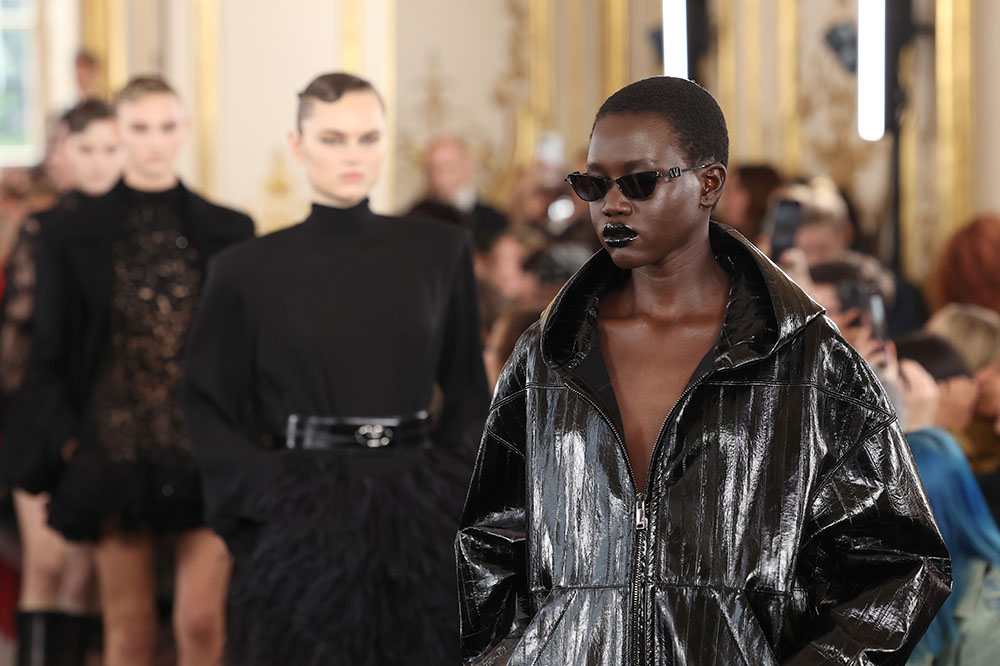
A model walks the runway during the Valentino Womenswear Fall/Winter 2024-2025 show as part of Paris Fashion Week on March 3 in Paris.
Pascal Le Segretain/Getty Images

The creative director of Maison Valentino, Pierpaolo Piccioli, has always considered color a powerful channel of immediate and direct communication, systematically used as a means of altering perception and reevaluating form and function. First, he focused on red, inherited from Valentino, the founder of the brand, then the pink of the past seasons, and now it’s the turn for black.
For the Valentino Le Noir Fall/Winter 2024 collection, shown during Paris Fashion Week in Saint-Germain-des-Prés, Piccioli presented Valentino through the lens of black, which does not represent an absence of color, nor an exercise in monochromy or monotony, but rather the discovery of a whole spectrum of hues. Celebrities sitting front row at the show included The Bear‘s Molly Gordon, Bridgerton‘s Simone Ashley and singer Gracie Abrams.
“Baudelaire said that black is the uniform of democracy, and this phrase seems more relevant to me today than ever before. Not only because it is the color that is worn most often, but because it represents both universality and individuality. At this moment in history, I felt the need to give up color to say something more through the choice of one color that encapsulates all the others. It is my way of shaping this reactionary period we are living in,” the designer explained on the sidelines of the fashion show.
As a color, black has always held within itself a multitude of definitions and meanings, constantly changing. Mark Rothko’s blacks. Pierre Soulages’ reflective blacks. Constantin Brâncuși’s sculptural black forms. Representative of universality and individuality, of uniformity and idiosyncrasy, black acts physically like no other color, absorbing light.

A model walks the runway during the Valentino Womenswear Fall/Winter 2024-2025 show as part of Paris Fashion Week on March 3 in Paris.
Pascal Le Segretain/Getty Images
“Monochrome allows you to see everything better, to look deeper. I chose black not as an absence of color but as an infinite range of possibilities,” said Piccioli, illustrating his mood board before the fashion show. “It is like a canvas, a starting point on which to build layers and structures, silhouettes that could move in search of the lights around, to absorb and reflect them. It is more a composition that is the result of different individualities. A choral architecture that guards light as the most precious secret. Only when you are in the dark do you look for light.”
In this collection, black is amplified, used to ponder Valentino’s signs and signifiers: rosettes, ruffles, embroidery and lace. Patterns, embroidery and fabrics give black different lives, a craft technique Valentino calls altorilievo (embossing) that is performed on tulle, which falls like shadows on the body.
Shapes are sculpted by intense velvets and crepe, while the transparencies of chiffon veil the skin. Valentino’s archetypal silhouettes, glamorous lines and defined shoulders that unmistakably are reminiscent of the 1980s, are modernized without nostalgia, accentuated to define today’s bodies.
It was among these sumptuous halls, embellished with gilded stuccoes, large mirrors and majestic crystal chandeliers — with a sublime soundtrack created by Oscar winner Alexander Desplat and his wife Solrey resounding in the air — that a juxtaposition in black, between lightness and solidity, past and present, played out.